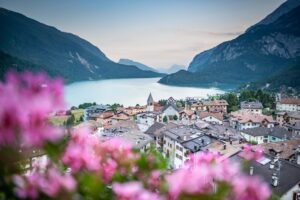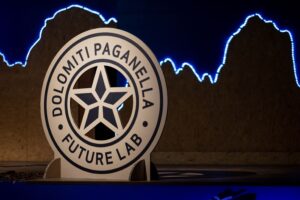? Destination Stewardship Report – Summer 2020 ?
In the last five years, Dolomiti Paganella DMO in the Trentino region in northern Italy has transitioned from a fairly disorganized structure with no community support into a well-managed, prosperous and widely-supported destination management body focused on stakeholder cooperation and sustainability. The DMO’s innovative Future Lab initiative is now helping to shape a roadmap to post-Covid19 recovery in the first region in Europe hit by the coronavirus. Marta Mills explains how.
In Italy’s Dolomites, a “Future Lab” Inspires DMO Innovation
By Marta Mills

Dolomiti Paganella Tourism Board is a regional DMO (Destination Management Organization) comprising five municipalities in the Dolomites, a mountain range in the northern Italian Alps. The region became a UNESCO World Heritage Site in 2009 because of its ‘intrinsic, exceptional natural beauty’. According to UNESCO, the Dolomites are ‘widely regarded as being among the most attractive mountain landscapes in the world. Their dramatic vertical and pale-coloured peaks in a variety of distinctive sculptural forms is extraordinary in a global context.’
Before 2015, the Dolomiti Paganella DMO suffered high seasonality, low funding, lack of long-term vision for tourism, and no clarity on the DMO’s role. The DMO used to manage a lot of different, ad-hoc projects, lacking in specialization, coordination, and leadership. This created unrealistic expectations and demands from the local stakeholders, and also meant that, according to its current Director Luca D’Angelo, the DMO was ‘doing everything for everybody and with no prioritization of tasks, and hence doing it badly’.
The DMO began shifting into sustainability in 2015. Its newest initiative is a research-intervention think-tank on the future of tourism in the region. Launched on 29 October 2019, The Future Lab is engaging not only the industry stakeholders but also – and for the first time – the whole community.
The Destination
Dolomiti Paganella is the brand name of the destination, Paganella being one of the peaks. The five picturesque ‘communes’ – Molveno, Andalo, Fai Della Paganella, Cavedago, and Spormaggiore – are surrounded by imposing, vertical rock walls, sheer cliffs and a high density of narrow, deep and long valleys. They provide opportunities for adventure tourism (mountain biking, climbing, hiking, paragliding and skiing) and family-oriented experiences, with several aquaparks, wellness centres, and family festivals.
Interestingly, out of the two million overnight stays annually, 65% visit in the summer. That’s unusual for the Alps, where most visitors come in the winter. However, the facilities around the stunning Molveno Lake and a strong Bike Product developed by the DMO allow Dolomiti Paganella to spread the tourism season much wider compared to other alpine destinations.
The Change
In January 2015, Luca D’Angelo, former senior tourism researcher at the nearby Trentino School of Management (TSM) and a director of another DMO in Trentino (Valsugana), took charge of the Dolomiti Paganella DMO. Together with the TSM, he used a St Gallen Strategic Visitor Flow model to work out visitor flows and decided to focus on only four products (biking, hiking, climbing and family experiences). That shifted the promotion of the destination as a whole into developing and promoting specific products, which subsequently changed the whole structure and the strategy of the organization. Such specialization allowed the DMO to prioritize its activities and focus on a long-term vision.
Stakeholder cooperation
Initially, DMO-stakeholder cooperation focused on product development, forming new funding partnerships with local businesses (cable car companies, trail builders, accommodation providers) and the local municipalities who own the land. They jointly create and sell experiences that are then promoted by the DMO through their online channels. The focus on developing selected products (Bike Product for example) and strong cooperation with local business has built trust that allows more participatory, more efficient destination management.

Every year the DMO organizes two to three workshops with lift companies, bike chalets and bike hotels to jointly visualize the short and long-term goals for the destination in the next two to three years. Involving key industry players has been fundamental both in creating a strategy for the destination and for developing quality product.
Results and Impacts
The change has raised destination visibility, extended the season from April to November and broadened the visitor market. The growth in visitor numbers – 500%, from 2015 through 2019 – has significantly increased the revenue for the DMO and for the businesses. However, this growth came with negative environmental costs, and in the summer months overtourism became an issue for residents increasingly concerned about the region’s capacity for yet more visitors. Their enthusiastic support for the growth that had brought economic benefits started giving way to worry that overtourism was hurting quality of life for the communities. The FutureLab was the DMO’s response.
Next Phase: The Future Lab
As the confidence and trust in the DMO rose, it was the right time for The Future Lab to engage the local population in deciding on the future of tourism ‘as a positive force for the good of our community tomorrow and in future decades’. The Future Lab is involving hundreds of stakeholders in defining the role of tourism in the region, aiming for a more environmentally and socially sustainable model that benefits local residents, the environment, visitors, and tourism businesses.
I learned about it during a week-long tourism training on management of UNESCO natural sites run by the TSM in November 2019. Funded by the DMO and run in partnership with the TSM and Frame & Work, the Future Lab is seen by the DMO as a more innovative and sustainable form of destination management, based on stakeholders’ views on how tourism can benefit them and the natural environment. Over 700 local people attended the launch on 29 October 2019, when consultation on the future started. Discussion focused on four issues:
- Destination’s DNA;
- Future generations’ involvement in destination development;
- Thriving in a future shaped by climate change;
- Improving tourism balance.
 The plan was to continue with stakeholder meetings and workshops in 2020, run by the DMO in cooperation with TSM and Frame & Work. A special Blog and the DMO’s Facebook group (only in Italian) allows the local people to check the updates and interact with the project. Before February 2020, over 20 workshops had been completed, and meetings with various associations and individuals willing to connect with the Future Lab were in full swing.
The plan was to continue with stakeholder meetings and workshops in 2020, run by the DMO in cooperation with TSM and Frame & Work. A special Blog and the DMO’s Facebook group (only in Italian) allows the local people to check the updates and interact with the project. Before February 2020, over 20 workshops had been completed, and meetings with various associations and individuals willing to connect with the Future Lab were in full swing.
And then the coronavirus happened.
The DMO and the Future Lab Respond to COVID-19
The most recent analyses predict that the turnover in the region will be 40% less compared with the previous year. During the pandemic, the DMO has focused on two areas:
- Supporting the tourism industry with constant updates; surveys on feelings and emotions; revision of the event calendar; and creation of a toolkit to help with cancellation, vouchers, revenue, social media communication, market insights, and so on.
- Creating a strong relationship with the tourism community. For the latter, they have created new content with a different vision of the future, as in this short video. The community was also surveyed about their feelings on travelling again. The DMO encourages the community to use this time constructively by focusing on ‘internal resources that can be exploited’ – in other words, tapping the ideas, know-how, skills, and experience that locals can exchange to help with recovery. ‘We are working on the re-start phase’, says Luca, ‘but at the same time looking for a “new” vision through the Future Lab. This is precisely the idea of the Future Lab: reflecting on today to conceive interesting prospects for the future’.
The next steps will be to reboot project communication and stakeholder engagement, stimulate a new involvement from the community, and build new research tools. ‘It is important to note that we do not aim to turn the Future Lab into a crisis management project for the current challenge’, Luca told me. ‘While there is plenty of work to be done as a DMO to offer continuous support for our local community now, the focus of the Future Lab remains firmly fixed on planning and preparing for a better future.’
Thus, the project is still what it set out to be: a lab focusing on the long-term development and strategic decisions for the destination. The Covid crisis has surely changed the context of the process, and partners TSM and Frame & Work are currently rescaling, refocusing and recharging the project. They intend to incorporate the lessons from the pandemic that can also be replicated in other destinations.
Luca has no plans to leave the DMO as this new phase is just beginning. Even if he were to depart, the Future Lab’s strong foundations, based on cooperation with partners and stakeholder approval, should ensure the continuity of the project.

